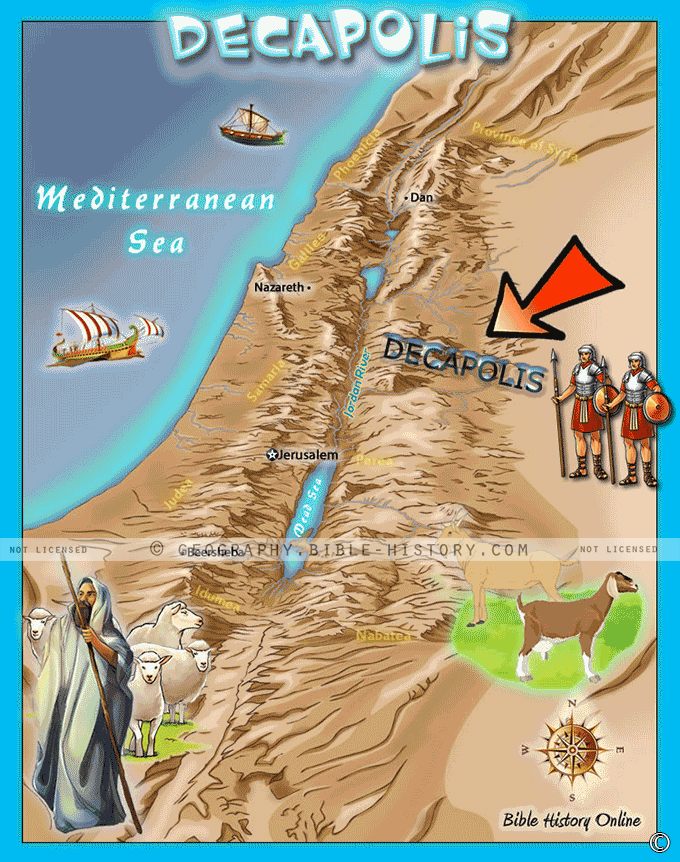
The Decapolis, a league of ten ancient cities, stands as a testament to the vibrant intersection of culture, trade, and urban life in the ancient Middle East. Spanning regions in what is now modern-day Jordan, Israel, and Syria, these cities were united by their Greek-influenced culture and shared dedication to urban development.
Origins and Unity
The Decapolis emerged during the Hellenistic period, a time when Greek culture and influence permeated the eastern Mediterranean. These ten cities, strategically located along trade routes and fertile lands, formed a league that promoted mutual cooperation in matters of commerce, governance, and culture.
City Highlights
Each city within the Decapolis had its own unique character and offerings. Jerash (Gerasa) in Jordan, for example, boasts remarkably preserved Roman ruins, including an impressive oval plaza and a stunning theater. Scythopolis (Beth Shean) in Israel is known for its well-preserved Roman baths and amphitheater. The city of Philadelphia (Amman) in Jordan, the modern capital, has a rich history and is a thriving hub of culture.
Cultural Exchange
The Decapolis was a melting pot of cultures. Greek, Roman, Nabatean, and Semitic influences converged, leading to a unique blend of architectural styles, languages, and religious practices. The cities' theaters, temples, and marketplaces bore witness to this cultural exchange.
Prosperity and Trade
Commerce thrived within the Decapolis. The cities' strategic locations along trade routes facilitated the exchange of goods, including spices, textiles, and precious metals. This prosperity allowed for the construction of grand structures and the patronage of the arts.
Decline and Legacy
The Decapolis began to decline with the spread of Christianity and changing political dynamics. The rise of Byzantine rule and Islamic conquests led to shifts in the region's urban centers. Nevertheless, the legacy of the Decapolis endures through its archaeological treasures, which provide valuable insights into the cultural and economic dynamics of the ancient world.
The Decapolis stands as a remarkable testament to the flourishing urban life, cultural diversity, and thriving commerce of the ancient Middle East. These ten cities, bound by a shared commitment to growth and cooperation, offer a window into the rich tapestry of human history, where different cultures and influences converged and left an indelible mark on the landscape and legacy of the region.
Blank Topo Map of The World
Abraham’s Journey
The Captivity of Judah (586-516 B.C.)
The Fall of Judah 586 B.C.
The Northern Kingdom of Israel
The Southern Kingdom of Judah
The Divided Kingdom
The Fertile Crescent
Ur of the Chaldees
Shechem in Old Testament Times
Prophets, Kings, and Nations
Jesus Last Passover
New Testament Israel
New Testament Places
Old Testament Israel
Provinces of the Roman Empire
Israel during David’s Kingdom
David’s Kingdom
Cities of the New Testament 4
Cities of the New Testament 3
Cities of the New Testament 2
Mediterranean Sea
Cities of the New Testament
First Century Jerusalem
Empire of David and Solomon
David’s Kingdom
Israel Under Rehoboam
Ophir and Tarshish
The Period of the Kings
Ramoth Gilead
Samaria
Solomon’s Temple
Zarephath and MT Carmel
Jabesh Gilead and Tribes
Judah in the Time of David
Kingdom of Saul
Kirjath Jearim
Michmash
Mount Gilboa in the Time of David
Nob Davids Flight
Shiloh
Israel and Judah
Assyrian Empire Under Esarhaddon
Assyrian Empire Under Sennacherib
Captivity of 10 Tribes
Events in 2 Kings
The Khabur River
Israel and Syria
Captives From Judah
Kingdom of Jeroboam
Mesha’s Kingdom
Pharaoh Necho Battles King Josiah at Megiddo
Babylonian, Mede and Persian Empires
Samaria and Nearby Territories
Syria at its Height
Hebron
Mahanaim
1949 Map of Israel With Boundaries
First & Second Journeys of Paul
Journeys of the Apostles
Paul’s Third Missionary Journey
Saul’s Journey to Damascus and Arabia
Paul’s Final Visits
Paul’s 1st Missionary Journey
Paul’s 2nd Missionary Journey
Paul’s 3rd Missionary Journey
Paul’s Voyage to Rome
Phillip Journeys to Samaria and Gaza
Judah at the Time of Amos
Empire of Alexander the Great
Israel Under the Maccabees
Galilee During Maccabees
Idumea Intertestamental Period
Kingdom of the Ptolemies
Kingdom of the Seleucids
Ptolemaic Egypt Seleucid Asia
The Roman World
Kingdom of Ptolemies and Seleucids
The World During the 6TH Century BC
Mount Horeb
The Red Sea
The Exodus
Ezra’s Journey to Restore Jerusalem
Israel and Judah During Hosea’s Time
The Ancient World
Canaan During the Time of Abraham
The City of Shechem
Supposed Location of the Garden of Eden
The Land of Israel in Genesis
The Jordan River
The Kingdom of Nimrod
Mount Ararat and Mesopotamia
The Descendants
Sodom and Gomorrah
The Kingdom of Egypt
The Hamites
The Kingdom of the Hittites
Ur of the Chaldees
Judah at the Time of Haggai
Jesus Passes Through Samaria
